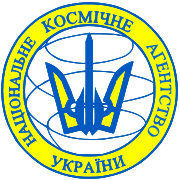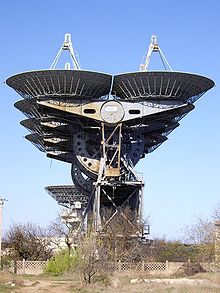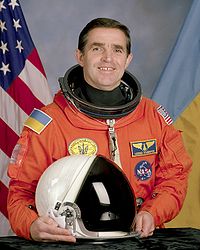- State Space Agency of Ukraine
-
State Space Agency of Ukraine
Державне космічне агентство України
Established February 1992 (as National Space Agency of Ukraine) Headquarters Kiev Primary spaceport all under lease Baikonur / Plesetsk Cosmodromes / Ocean Odyssey Administrator Yuriy Alekseyev[1][2] Budget $250–300 million[3] Website http://www.nkau.gov.ua/ The State Space Agency of Ukraine (SSAU; Ukrainian: Державне космічне агентство України, Derzhavne kosmichne ahentstvo Ukrayiny, ДКАУ, DKAU) is the Ukrainian government agency responsible for space policy and programs.
The former name (before December 9, 2010) - Національне космічне агентство України, НКАУ (the National Space Agency of Ukraine, NSAU[4]
NSAU is a civil body in charge of co-ordinating the efforts of government installations, research, and industrial companies (mostly state-owned). Several space-related institutes and industries are directly subordinated to NSAU. However, it is not a united and centralized system immediately participating in all stages and details of space programs (like NASA in the United States). A special space force in the military of Ukraine is also absent.
The agency oversees launch vehicle and satellite programs, co-operative programs with the Russian Aviation and Space Agency, the European Space Agency, NASA, and commercial ventures. International participation includes Sea Launch and the Galileo positioning system.
Launches are conducted at Kazakhstan's Baikonur, Russia's Plesetsk Cosmodromes, Alcântara Launch Center (Brazil), and on Sea Launch's floating platform. NSAU has ground control and tracking facilities in Yevpatoria, Crimea, while the control-measuring complexes are located in Yevpatoria and Dunaivtsi (Khmelnytskyi Oblast).
Ukrainian spacecraft includes few kinds for own and foreign use and international cooperation. Ukraine has supplied Russia with military satellites and their launch vehicles, a unique relationship in the world.
Ukraine became the tenth space power (country able to launch own satellite by own launcher) in 31 August 1995 (at start of Sich-1 on Tsyklon).[citation needed]
As of April 2009 the Ukrainian National Space Agency is planning to launch a Ukrainian communications satellite by September 2011 and a Sich-2 before the end of 2011.[5]
Contents
Main tasks
- Development of state policy concepts in the sphere of research and peaceful uses of space, as well as in the interests of national security;
- Organization and development of space activities in Ukraine and under its jurisdiction abroad;
- Contributing to state national security and defense capability;
- Organization and development of Ukraine’s cooperation with other states and international space organizations.
Space program
 First launch at Sea Launch complex of Ukrainian Zenit3SL LV
First launch at Sea Launch complex of Ukrainian Zenit3SL LV
Space activities in Ukraine have been pursued over a 10-year span in strict accordance with National Space Programs. Each of them was intended to address the relevant current issues to preserve and further develop the space potential of Ukraine. The First Program (1993–1997) was called upon to keep up the research and industrial space-related potentiality for the benefit of the national economy and state security as well as to be able to break into the international market of space services. The Second Program (1998–2002) was aimed at creating an internal market of space services, conquering the international space markets by presenting in-house products and services (including launch complexes and spacecraft, space-acquired data, space system components) and integrating Ukraine into the worldwide space community.
The National Space Program of Ukraine for 2003-2007 (NSPU), which was adopted by the Verkhovna Rada of Ukraine (the Parliament of Ukraine) on October 24, 2002, outlines the main goals, assignments, priorities, and methods of maintaining space activity in Ukraine.
The Ukrainian Cabinet of Ministers announced its plans on 13 April 2007 to allocate 312 million euros to the National Space Program for 2007-2011.
Specific programs
- Scientific space research
- Remote sensing of the Earth
- Satellite telecommunication systems
- Development of ground-based infrastructure for navigation and special information system
- Space activities in the interests of national security and defense
- Space complexes
- Development of base elements and advanced space technologies
- Development of research, test and production base of the space sector
Goals of the program
- To develop a national system for Earth observation from outer space to meet the national demands in the social economic sphere and for security and defense purposes
- To introduce satellite systems and communication facilities into the telecommunication infrastructure of the state
- To obtain new fundamental knowledge on near-Earth outer space, the solar system, deep space, biological and physical processes and the microgravity condition
- To create and develop techniques for space access with a view toward realizing national and international projects and to enable the home-made rocket to be employed on the worldwide market of space transportation services
- To elaborate the advanced space facilities
- To ensure the innovative development of the space sector in terms of improving its research, experimental and production basis
National enterprises of space industry
Most of the enterprises are located in Dnipropetrovsk or Kiev
- Dnipropetrovsk
- State Enterprise Makarov Yuzhny Machine-Building Plant (Yuzhmash)
- State Enterprise Yangel Yuzhnoye State Design Office
- State Enterprise "Dniprokosmos"
- State Enterprise "Dniprovsky Project Institute"
- Makarov National Center of aero-cosmic education for the youth
- State Enterprise "Center of rocket-space technology standardization"
- State Enterprise "Nikopol Pipe Plant"
- State Enterprise "Pavlohrad Chemical Plant"
- Kiev
- State Enterprise "Arsenal Factory[1]"
- State Enterprise "Ukrkosmos"
- State Enterprise "Kyivprylad"
- State Enterprise "Scientific Center of a Precise Machine-building"
- State Joint-Stock Holding Company "Kiev Radio Plant" (former Production Complex)
- Open Joint-Stock Association "Kiev Radio Plant"
- Open Joint-Stock Association "RSB-Radio Plant"
- Open Joint-Stock Association "SPC Kurs"
- State Scientific-Production Center "Pryroda"
- State Scientific-Production Enterprise "Ukrainski innovatsiyni promyslovi tekhnolohii"
- Kharkiv
- Science-research technological institute of instrument-building (NDTIP)
- Crimea
- National Space Facilities Control and Testing Center
Ukrainian launch vehicles
During 1991-2007, a total of 97 launches of Ukrainian LV were conducted, including, but not limited to launches on the Sea Launch mobile launch pad. In 2006 Ukrainian launch vehicles accounted for 12.1% of all launches into space in the world.
Ukrainian companies Yangel Yuzhnoye State Design Office and Makarov Yuzhny Machine-Building Plant (Yuzhmash) have engineered and produced seven types of launch vehicles. Adding strapon boosters to launch vehicles may expand the family of Mayak, which is the latest launch vehicle developed.
Ukrainian satellites
Ukraine produced the Sich and Okean Earth observation satellites, few other types of satellites and the Coronas solar observatory in cooperation with Russia.
For own use NSAU has engineered, constructed and launched a total of 6 satellites (since 1992). The latest Ukrainian satellite, Sich-1M, was launched in 2004 and was a successful mission. The launch of Sich-2 was scheduled in 2007 with a goal of scientific research and space exploration; it was launched in August 2011.[6] NSAU is currently working on further Sich series satellites: Sich-3, Sich-3-O and Sich-3-P; and a "lunar" satellite to fly around the Moon in 2017.[7]
Human flights
Prior to Ukraine's independence, several Ukrainians flew in space under the Soviet flag. The first Ukrainian to fly in space under the Ukrainian flag was Leonid K. Kadenyuk on 13 May 1997. He was a payload specialist on NASA's STS-87 Space Shuttle mission. It was an international spaceflight mission, involving crew members from NASA (USA), NSAU (Ukraine) and NASDA (Japan).
Sea Launch project
- See more detailed article at Sea Launch
Sea Launch is joint venture space transportation company, partially owned by companies in Ukraine[8] which handle operations for the National Space Agency. Sea Launch offers a mobile sea platform, used for spacecraft launches of commercial payloads on specialized Ukrainian Zenit 3SL rockets. The main advantage of the floating cosmodrome is its placing directly on the equator. It allows taking greatest advantage of Earth's rotation for delivering payloads into orbit at low expense.
Within the framework of the project the space rocket complex was developed, which consists of four components:
- marine segment
- rocket segment
- spacecraft segment and
- facilities
Svityaz project
The Svityaz aerospace rocket complex (ASRC) is intended for launching of various spacecraft (SC) into circular, elliptic and high-altitude circular, including the geostationary (GSO), orbits. Svityaz ASC represents a unique system that allows launch of spacecraft without utilization of complicated ground infrastructure. The Svityaz is launched directly from a modified version of Mriya, a Ukrainian airplane and airplane carrier that is currently the largest one in the world. Modified Mriya that will be used to carry Svityaz has been designated a code of An-225-100.
The aircraft is equipped with special devices to secure the LV above the fuselage. The operators and onboard equipment are located in the pressure-tight cabins. The Svityaz LV is being created on the basis of units, aggregates and systems of Zenit LV. It consists of three stages of non-toxic propellants - liquid oxygen and kerosene. The launch vehicle is injected into the geostationary orbit using a solid-propellant apogee stage.
See also
- Lviv Centre of Institute for Space Research
- A_Message_From_Earth - A Message from Earth (AMFE) was sent by NSAU towards Gliese 581 c, a large terrestrial extrasolar planet orbiting the red dwarf star Gliese 581. The signal is a digital time capsule containing 501 messages.
References
- ^ Dr. Yuriy Alekseyev was assigned a Director General of the National Space Agency of Ukraine, National Space Agency of Ukraine Official web-site (March 18, 2010)
- ^ Direction of NSAU, National Space Agency of Ukraine Official web-site
- ^ http://www.niss.gov.ua/cacds/archivee/April/0414c.html
- ^ Указ Президента України № 1085 від 9 грудня 2010 року «Про оптимізацію системи центральних органів виконавчої влади» (Ukrainian)
- ^ National Space Agency Planning To Launch Ukrainian Communications Satellite By September 2011, Ukrainian News Agency (April 10, 2009)
- ^ Dnepr launches with Ukraine’s Sich-2 and several passengers, NASAspaceflight.com (August 17th, 2011)
- ^ Ukraine plans to send research satellite to Moon in 2017, Kyiv Post (10 November 2011)
- ^ Ukraine's government ready to reanimate Sea Launch project, Kyiv Post (May 27, 2010)
External links
- English-language home page
- Ukrainian space history on Astronautix.com encyclopedia
- Ukraine's Space Program - article in Moscow Defense Brief
- NASA, Ukraine Prepare Flights to Moon, RedNova News
- Ukrainian Rockets to Orbit U.S. Satellites, Novosti
- Yuzhnoe SDO, major Ukrainian Space Technologies Design Bureau
Public sector space agencies Africa North AfricaSub-SaharanAmericas North AmericaSouth AmericaAsia East AsiaSoutheast AsiaSouth AsiaSouthwest AsiaCentral AsiaEurope Oceania World See also: Timeline of first orbital launches by country · 1 Preceded by the Soviet space program Categories:- Space agencies
- Ukrainian space program
Wikimedia Foundation. 2010.





